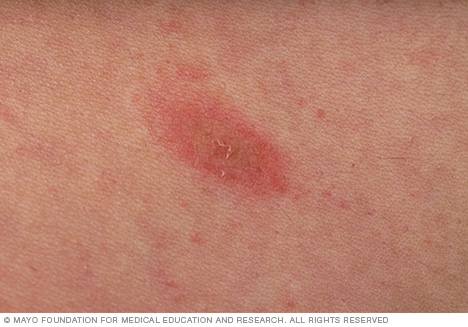Pityriasis rosea
Pityriasis rosea
overview
Pityriasis rosea (initial phase)

Pityriasis rosea (initial phase)
Pityriasis rosea typically begins with a large, slightly raised, scaly patch called a herald patch.
Pityriasis rosea (rash)

Pityriasis rosea (rash)
Pityriasis rosea is a fine, itchy, scaly or bumpy rash that usually first appears as a single spot (A) anywhere on the body. This rash (Herald Patch) disappears. Then, a few days to a few weeks later, another rash breaks out across the face, back, or chest in a pattern that resembles drooping branches of a pine tree (B).
Pityriasis rosea is a skin rash that often begins as an oval spot on the face, chest, stomach, or back. This is called a herald patch and can be up to 10 centimeters wide. Then you may get smaller spots radiating from the center of the body in a shape that looks like drooping pine branches. The rash may itch.
Pityriasis (pit-ih-RIE-uh-sis) rosea can occur at any age, but is most common between the ages of 10 and 35. It usually disappears on its own within 10 weeks.
Treatment can help relieve symptoms.
The rash lasts for several weeks and heals without scarring. Medicated lotions can relieve itching and speed up the disappearance of the rash. However, treatment is often not necessary. The disease is not contagious and rarely recurs.
Symptoms
Pityriasis rosea typically begins with an oval, slightly raised, scaly patch - called a herald patch - on the face, back, chest or stomach. Before the Herald patch appears, some people have a headache, fatigue, fever, or sore throat.
A few days to a few weeks after the Herald patch is released, you may notice small bumps or scaly patches on your face, back, chest, or stomach that look like a Christmas tree pattern. The rash can cause itching.
When to go to the doctor?
See your doctor if you develop a rash that gets worse or hasn't gone away in three months.
Causes
The exact cause of pityriasis rosea is unclear. It can be caused by infection with a virus, particularly certain strains of the herpes virus. But it is not related to the herpes virus that causes cold sores. Pityriasis rosea is not contagious.
Complications
Complications of pityriasis rosea are not likely. When they occur, they can include:
- Starker Juckreiz
- Vorübergehende (Wochen bis Monate andauernde) Hautflecken, die dunkler oder heller als gewöhnlich sind (postentzündliche Hyperpigmentierung oder Hypopigmentierung), was bei Menschen mit brauner oder schwarzer Haut wahrscheinlicher ist
Sources:
- Fragen Sie MayoExpert. Pityriasis rosea. Mayo-Klinik; 2022.
- Kliegman RM, et al. Erkrankungen der Epidermis. In: Nelson Lehrbuch der Kinderheilkunde. 21. Aufl. Elsevier; 2020. https://www.clinicalkey.com. Abgerufen am 26. April 2022.
- Kelly AP, et al., Hrsg. Pityriasis rosea. In: Taylor und Kelly’s Dermatology for Skin of Color. 2. Aufl. McGraw-Hügel; 2016. https://accessmedicine.mhmedical.com. Abgerufen am 26. April 2022.
- Pityriasis rosea. Amerikanische Akademie für Dermatologie. https://www.aad.org. Abgerufen am 26. April 2022.
- Pityriasis rosea. Merck Manual Professional-Version. http://www.merckmanuals.com/professional/dermatologic_disorders/psoriasis_and_scaling_diseases/pityriasis_rosea. Abgerufen am 26. April 2022.
- Kelly AP, et al., Hrsg. Pädiatrie. In: Taylor und Kelly’s Dermatology for Skin of Color. 2. Aufl. McGraw-Hügel; 2016. https://accessmedicine.mhmedical.com. Abgerufen am 26. April 2022.
- Fragen Sie MayoExpert. Lippenherpes (Herpes-simplex-Infektion). Mayo-Klinik; 2022.
- Wie man juckende Haut lindert. Amerikanische Akademie für Dermatologie. https://www.aad.org/public/everyday-care/itchy-skin/itch-relief/relieve-itchy-skin. Abgerufen am 27. April 2022.
- Sonnencreme: So schützen Sie Ihre Haut vor der Sonne. US Food and Drug Administration. https://www.fda.gov/Drugs/ResourcesForYou/Consumers/BuyingUsingMedicineSafely/UnderstandingOver-the-CounterMedicines/ucm239463.htm. Abgerufen am 26. April 2022.
- Häufig gestellte Fragen zu Sonnenschutzmitteln. Die Amerikanische Akademie für Dermatologie. https://www.aad.org/media/stats-sunscreen. Abgerufen am 26. April 2022.
- Fragen Sie MayoExpert. Sonnenbrand. Mayo-Klinik; 2022.

 Suche
Suche
 Mein Konto
Mein Konto